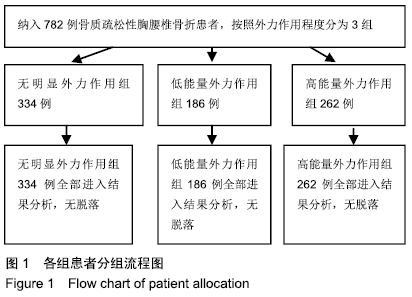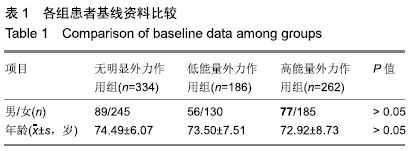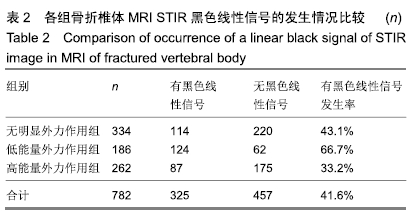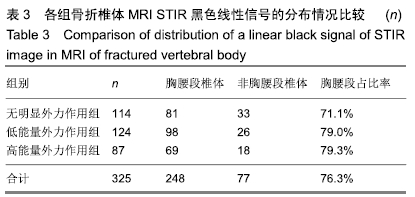中国组织工程研究 ›› 2020, Vol. 24 ›› Issue (9): 1400-1404.doi: 10.3969/j.issn.2095-4344.2512
• 骨与关节图像与影像 bone and joint imaging • 上一篇 下一篇
骨质疏松性胸腰椎骨折MRI STIR黑色线性信号与外力程度的关系
钟远鸣1,罗 满2,唐福波1,唐 成3
- 1广西中医药大学第一附属医院,广西壮族自治区南宁市 530001;2广西国际壮医医院,广西壮族自治区南宁市 530001;3柳州市中医医院,广西壮族自治区柳州市 545001
Relationship between a linear black signal area of STIR image in MRI of osteoporotic thoracolumbar fracture and the size of external force
Zhong Yuanming1, Luo Man2, Tang Fubo1, Tang Cheng3
- 1The First Affiliated Hospital of Guangxi University of Chinese Medicine, Nanning 530001, Guangxi Zhuang Autonomous Region, China; 2Guangxi International Zhuang Medical Hospital, Nanning 530001, Guangxi Zhuang Autonomous Region, China; 3Liuzhou Traditional Chinese Medicine Hospital, Liuzhou 545001, Guangxi Zhuang Autonomous Region, China
摘要:
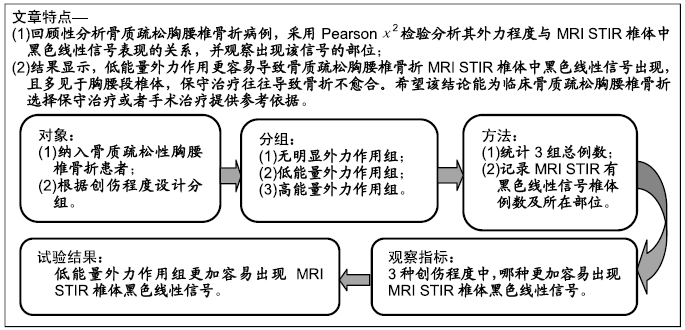
文题释义:
MRI STIR椎体内黑色线性信号:指的是在MRI T2压脂像中,骨折椎体内会出现高信号,在骨折椎体高信号中有线性低信号出现,且在椎体内,为椎体压缩性骨折的特殊表现,出现骨折椎体内黑色线性信号往往提示着骨折保守治疗不愈合。
背景:随着社会老龄化加重,骨质疏松椎体骨折患者日益增多,主要表现为胸腰椎体压缩性骨折,严重影响老年人的日常生活。因此,研究外力程度与骨质疏松胸腰椎体骨折在影像MRI STIR上表现的关系,可以更好的为临床诊疗提供依据。
目的:探讨外力作用程度与骨质疏松性胸腰椎骨折MRI STIR黑色线性信号的相关性。
方法:回顾性分析2013年9月至2016年9月在广西中医药大学第一附属医院脊柱外科住院,明确诊断为骨质疏松性胸腰椎骨折的患者,3组中所有病例均行定量CT检查确诊为骨质疏松(骨密度值≤80 mg/cm3)。所有患者对治疗方案均知情同意,且得到医院伦理委员会批准。根据创伤史,分为无明显外力作用组(无明显诱因、无外力作用等)、低能量外力作用组(扭伤、弯腰提重物、扛重物等)、高能量外力作用组(平路摔倒臀部着地、跌倒、撞伤等),统计各组间性别、年龄、骨折部位(胸腰段和非胸腰段)、MRI STIR黑色线性信号椎体例数及所在的部位(胸腰段和非胸腰段)。3组间年龄属于计量资料采用方差分析;性别、骨折部位、MRI STIR黑色线性信号的椎体数量及所在部位属于计数资料,用Pearsonχ2检验。
结果与结论:①纳入的3组病例共782例。无明显外力作用组334例,其中椎体内黑色线性信号114例;低能量外力作用组186例,其中椎体内黑色线性信号124例,高能量外力作用组262例,其中椎体内黑色线性信号87例;②3组间年龄、性别、骨折部位、MRI STIR黑色线性信号所在椎体部位差异均无显著性意义(P > 0.05);③3组间MRI STIR黑色线性信号比较差异有显著性意义(P < 0.05),分割P值,降低检验水准(α´=0.05/3=0.017)。低能量外力作用组分别与无明显外力作用组、高能量外力作用组比较,差异有显著性意义(P< 0.017);无明显外力作用组与高能量外力作用组比较,差异无显著性意义(P > 0.017);④并且低能量外力作用组中MRI STIR黑色线性信号出现率为66.7%,明显大于其他2组的43.1%和33.2%;⑤提示在创伤史中,相对于无明显外力作用和高能量外力作用,低能量外力作用的骨质疏松性胸腰椎骨折更容易导致MRI STIR黑色线性信号的出现,并且多见于胸腰段椎体。
ORCID: 0000-0003-4441-4355(钟远鸣)
中国组织工程研究杂志出版内容重点:人工关节;骨植入物;脊柱;骨折;内固定;数字化骨科;组织工程
中图分类号:
